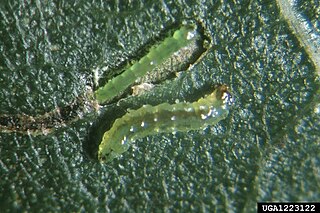
A leaf miner is any one of numerous species of insects in which the larval stage lives in, and eats, the leaf tissue of plants. The vast majority of leaf-mining insects are moths (Lepidoptera), sawflies, and flies (Diptera), though some beetles also exhibit this behavior.

The serpentine leaf miner is the larva of a fly, Liriomyza brassicae, in the family Agromyzidae, the leaf miner flies. It mines wild and cultivated plants, such as cabbage, broccoli, cauliflower and Chinese broccoli.
Trissodoris honorariella, the pandanus leaf perforator or pandanus hole-cutter moth, is a small cosmet moth species. It belongs to subfamily Cosmopteriginae and is the type species of the genus Trissodoris. Baron Thomas Walsingham in 1907 had specimens from both ends of the species' range – New Guinea and Pitcairn Island – which he described as separate species Stagmatophora honorariella and S. quadrifasciata in the same work. But his mistake was soon recognized, and when Edward Meyrick established the genus Trissodoris in 1914, he chose the former name to be valid.
Perittia lonicerae, the honeysuckle leaf miner, is a moth of the family Elachistidae. It was first discovered in Hawaii in 1949. It was later found in Japan in 1982, although it was described as new. Several other species are known from the eastern Palearctic Region, so it is likely that P. lonicerae originated there instead of Hawaii where it was first found.
Paralopostega peleana is a moth of the family Opostegidae. It was first described by Otto Swezey in 1921. It is endemic to the Hawaiian islands of Oahu and possibly Kauai.
Paralopostega serpentina is a moth of the family Opostegidae. It was first described by Otto Swezey in 1921. It is endemic to the Hawaiian islands of Oahu and possibly Kauai.
Merimnetria multiformis is a moth of the family Gelechiidae. It was first described by Edward Meyrick in 1928. It is endemic to the Hawaiian island of Oahu and possibly Hawaii.

Hellula undalis, the cabbage webworm or Old World webworm, is a moth of the family Crambidae. It is a widespread species which is found from Europe across Asia to the Pacific. It was first described from Italy.
Mestolobes pyropa is a moth of the family Crambidae described by Edward Meyrick in 1899. It is endemic to the Hawaiian islands of Oahu and Molokai.

Philodoria is a genus of moths in the family Gracillariidae. All species are endemic to Hawaii. It was first described by Lord Walsingham in 1907.
Cremastobombycia lantanella, the lantana leaf miner, is a moth of the family Gracillariidae. It was first described by August Busck in 1910. It is native to the southern United States and Mexico. It was introduced to Hawaii in 1902 to aid in the control of Lantana plants.
Caloptilia mabaella, the Hawaiian ebony leaf miner, is a moth of the family Gracillariidae. It was first described by Otto Herman Swezey in 1910. It is only known from the Hawaiian island of Oahu in the United States.
Philodoria dubautiella is a moth of the family Gracillariidae. It was first described by Otto Swezey in 1913. It is endemic to the Hawaiian island of Oahu.
Philodoria hibiscella, the hibiscus leaf miner, is a moth of the family Gracillariidae. It was first described by Otto Swezey in 1913. It is endemic to the Hawaiian islands of Oahu and Hawaii.
Philodoria marginestrigata, the ilima leaf miner, is a moth of the family Gracillariidae. It was first described by Lord Walsingham in 1907. It is endemic to the Hawaiian islands of Nihoa, Kauai, Oahu, Molokai and Hawaii.
Philodoria basalis is a moth of the family Gracillariidae. It was first described by Lord Walsingham in 1907. It is endemic to the Hawaiian islands of Maui and Hawaii.

Philodoria splendida is a moth of the family Gracillariidae. It was first described by Lord Walsingham in 1907. It is endemic to the Hawaiian islands of Kauai, Oahu, Molokai, Lanai and Hawaii.
Bucculatrix thurberiella, the cotton leaf perforator, is a species of moth of the family Bucculatricidae. It was first described by August Busck in 1914. It is native to the south-western United States and northern Mexico. It is an introduced species in Hawaii.
Bedellia oplismeniella is a moth of the family Bedelliidae. It was first described by Otto Swezey in 1912. It is endemic to the Hawaiian Islands, specifically to Oahu and possibly Molokai and Hawaii.
Bedellia orchilella, the Hawaiian sweet potato leaf miner, is a moth of the family Bedelliidae. It was first described by Lord Walsingham in 1907. It is endemic to the Hawaiian islands of Kauai, Oahu, Molokai, Maui and Hawaii.



